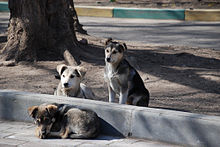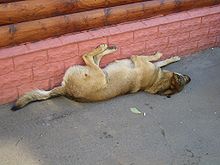- Stray dogs in Moscow
-
Among Moscow's large population of homeless canines, a small minority who frequent or inhabit its metro have attracted international attention due to their having learned how to use the trains to commute to and from various locations.
Contents
Background
The issue of Moscow's stray dogs was first mentioned by Russian writers such as journalist Vladimir Gilyarovsky in the late 19th century.[1] As of March 2010, there was an estimated 35,000 homeless dogs living within Moscow's city limits,[2] or approximately one stray dog for every 300 people, and about 84 strays per square mile.
According to Andrei Poyarkov of the A.N. Severtsov Institute of Ecology and Evolution, a biologist and wolf expert who has studied Moscow's strays for over 30 years, the quantity of food available to them keeps the total population of homeless dogs steady at about 35,000. Most pups born to strays don’t reach adulthood, and those that do essentially replace adults who have died. A life of more than 10 years is considered rare. Many if not most of them share certain physical similarities: medium-sized with thick fur, wedge-shaped heads and almond eyes, with long tails and erect ears.[1]
Most strays not born homeless arrive on the streets as rejected or abandoned house pets. Poyarkov estimates that fewer than 3 percent of abandoned pet dogs live long enough to breed.[1]
Over the years that Poyarkov observed the dogs, he observed the population lose spotted coats, wagging tails, and friendliness, characteristics known to separate dogs from wolves. He classified their evolving social structures into four groups:
- Wild dogs (feral and nocturnal, avoiding humans and viewing them as a threat)
- Foragers (semi-feral)
- Guard dogs (who view certain humans as their leaders)
- Beggars (the most intelligent, socialized to people but not affectionate or personally attached).[1]
The urbanized beggars in particular are unfazed by high levels of activity going on around them,[2] even managing to sleep in the midst of busy areas.[3] They also have the most specialized behaviors,[1] behaviors which differentiate them from both domesticated dogs and wolves. Beggars may exist in packs, but their leaders interact with other packs, and the leaders are not necessarily the strongest or most dominant dog, but rather the most intelligent, and are acknowledged as such by the other dogs in the pack who depend on them for survival. In packs of beggars, the smartest dog, not the most physically dominant, occupies the alpha position.
One technique a pack uses involves deploying its smaller, cuter members, having realized that these dogs have more success begging food off of people.[3] Another technique some dogs have for getting food is to sneak up behind a person who is holding some. The dog will then bark, which sometimes startles the human enough to drop it. The dogs have learned to cross the street with pedestrians and have been observed obeying traffic lights.[2] Since dogs have dichromatic vision, researchers theorize that the dogs recognize other cues, such as the shapes or positions of the changing signals. The dogs have become adept at intuiting the psychology of individual humans in order to determine which techniques will work best on whom. Dogs who locate themselves in high traffic areas realize that in such places they often won't need to make any effort to procure food, as pedestrians will simply toss it as they pass by. Malnourished-looking dogs are uncommon. Food is often easy to come by, allowing dogs the luxury of being selective. The reduced need to compete for food has contributed to stable social behavior, although incidents in which humans were harmed by packs of dogs have been known to occur, particularly in less urban areas. According to Alexei Vereshchagin, a graduate student of Poyarkov's who has studied them, the dogs generally go out of their way to avoid conflict with humans, and defecation in busy areas is rare.[4] Among the general human population, the dogs are simultaneously viewed affectionately and as a problem,[2] and at worst are generally tolerated. Many people choose to feed them and some people will build basic shelters for them in winter. They have come to be considered by many a component of the city's character.[4] Sterilization efforts have had little effect on curtailing the population.[2]
Metro dogs
The Moscow Metro is the second most heavily used in the world by daily ridership. A total of about 500 strays on average live in its stations, especially during colder months. Of these dogs, about 20 are believed to have learned how to use the system as a means of commuting.[1] Theories to explain how they are able to correctly determine their routes include:
- an ability to judge the length of time spent on the train in between stations[3]/time intervals
- recognition of the place names announced over their train's loudspeaker
- the scents of particular stations[1]
- a combination of such factors.
They are said to prefer the quieter, less trafficked cars at the very front or back of the train.[3] Author Eugene Linden, a specialist in the subject of animal intelligence, believes the dogs' behavior exhibits "flexible open-ended reasoning and conscious thought".[2]
Malchik
In 2001, a woman who was on her way home with her terrier used a kitchen knife to stab to death a dog named Malchik, a black stray who had made Mendeleyevskaya station his home, guarding it against drunks and other dogs, because he had barked at them. The incident, which occurred in front of rush-hour commuters,[1] provoked outrage among celebrities and the general public.[4] The woman was arrested, tried and underwent a year of psychiatric treatment.[1] Funds were raised to erect a bronze statue of Malchik in memoriam, which now sits at the station's entrance.[4] Passersby are known to rub the statue's nose, "for luck".[2]
Dog attacks
One effect of the large feral population is a high and rising level of dog attacks.[5] In 2007 official statistics suggest that 20,000 attacks took place, of which 8,000 were sufficiently serious to require police or medical intervention[6] and at least one being fatal.[5] In part the problem is traced to status dogs (often of known aggressive breeds) that are abandoned when they become troublesome,[6] and in part due to those dogs living in forested areas that are less well socialized and more prone to aggressive territorialism.[4]
References
- ^ a b c d e f g h i Sternthal, Susanne (January 16, 2010). "Moscow’s stray dogs". Financial Times. http://www.ft.com/cms/s/2/628a8500-ff1c-11de-a677-00144feab49a.html. Retrieved April 30, 2010.
- ^ a b c d e f g Marquardt, Alex; Bill Blakemore, Ross Eichenholz (March 19, 2010). "Stray Dogs Master Complex Moscow Subway System". American Broadcasting Company. http://abcnews.go.com/International/Technology/stray-dogs-master-complex-moscow-subway-system/story?id=10145833&page=1. Retrieved April 30, 2010.
- ^ a b c d Wheeler, Virginia (April 11, 2009). "Wild Dogs Take Chewbilee Line". The Sun. http://www.thesun.co.uk/sol/homepage/news/article2372125.ece. Retrieved April 30, 2010.
- ^ a b c d e Schoofs, Mark (May 20, 2008). "Wall Street Journal: "In Moscow's Metro, a Stray Dog's Life Is Pretty Cushy, and Zoologists Notice"". Wall Street Journal. http://online.wsj.com/article/SB121123197068805001.html. Retrieved April 30, 2010.
- ^ a b Rossi, Alex (2008-07-04). "Crackdown On Moscow's Stray Dogs". Sky News. http://news.sky.com/skynews/Home/World-News/Moscow-Crackdown-On-100000-Stray-Dogs-After-Savage-Attacks/Article/200807115023485. Retrieved 2010-12-24.
- ^ a b ROLSKI, Tomek (2008-02-18). "Moscow Plagued by Packs of Wild Dogs". ABC News. http://abcnews.go.com/Travel/BusinessTravel/story?id=4305319&page=1. Retrieved 2010-12-24.
External links
- Alexander Bratersky On the Trail of City Funds Spent on Strays The Moscow Times, 30 July 2010
- Interactive website dedicated to the Moscow Metro's canine commuters and inhabitants (in Russian)
Categories:- Dogs
- Urban animals
- History of Moscow
- Mammals of Russia
- Feral dogs
Wikimedia Foundation. 2010.


